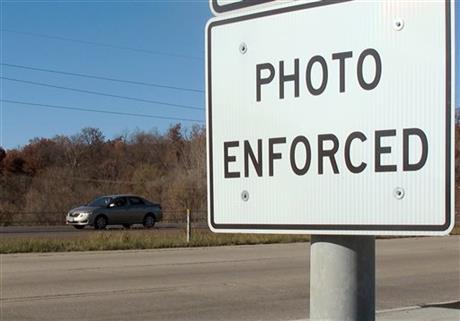
By RYAN J. FOLEY
In this Nov. 12, 2013 photo is a highway sign warning motorists along Interstate 380 in Cedar Rapids, Iowa that the speed limit is enforced by cameras. New state rules to rein in the use of speed cameras after their rapid expansion have set off a furor in municipalities that reflects how prized the cameras have become in many cities and how important they are to their budgets. (AP Photo/Ryan J. Foley)
Speed Cameras Iowa
In this Nov. 12, 2013 photo collision repair shop owner David Beer speaks to a customer at his office in Cedar Rapids, Iowa. A leading critic of speed cameras operated by the city, Beer is praising the Iowa Department of Transportation for proposing new limits that would tightly regulate their use. (AP Photo/Ryan J. Foley)
Speed Cameras Iowa
In this Nov. 12, 2013 photo vehicles pass a highway sign along Interstate 380 in Cedar Rapids, Iowa warning drivers that the 55-mph speed limit is enforced by speed cameras. Unmanned camera that enforce local speed limits have become a common roadside feature across the United States, but few places have embraced the devices with the zeal of Iowa they now produce more than 200,000 tickets and $13 million in fines annually, or more than $4 per Iowa resident. (AP Photo/Ryan J. Foley)
Prev
1 of 3
Next
CEDAR RAPIDS, Iowa (AP) — Unmanned “speed cameras” that enforce local speed limits have become a common roadside feature across the United States, but few places have embraced the devices with the zeal of Iowa.
Across the state, cities big and small have installed the cameras to deter speeding and generate revenue from tickets. The cameras now produce more than 200,000 tickets and $13 million in fines annually, or more than $4 per Iowa resident.
But the tactic may have become too popular among government and law enforcement officials. It’s now triggering a backlash over civil liberties and become an issue for the libertarian-minded Iowa Republican Party, with some complaining about out-of-control government.
Responding to those concerns, Republican Gov. Terry Branstad’s administration has proposed new limits that could shut down many of the cameras, allowing temporary use of the devices only as a last resort to address safety problems. The plan has set off a furor that reflects how prized the cameras have become in city halls and for city budgets.
“How can anybody say that they are not effective or they are not having an impact” on safety, said Wayne Jerman, police chief in Cedar Rapids, where cameras scan a stretch of Interstate 380 as it curves through the city. He said the city has seen no traffic fatalities in that historically dangerous stretch and far fewer accidents since the cameras were installed three years ago. “To me and the other chiefs, it just seems that our arguments aren’t good enough.”
At the center of the dispute is Iowa Department of Transportation Director Paul Trombino, a Branstad appointee who says the rules will ensure that safety, not money, is the factor behind the cameras’ use.
“Overall, what I’m sensing is that the public has a concern. What we’re trying to do is make sure that concern is heard and addressed,” said Trombino.
The rules would allow municipalities to ask for permission to use speed and red-light cameras only after other “engineering and enforcement solutions” had been tried. Cities would have to show that the cameras are targeting “documented high-crash or high-risk locations” and would have to justify their renewal every year. A legislative committee will review the new rules before they go into effect, as early as February.
The new rules are clearly popular among some motorists and their advocates.
“I think it’s unusual and it’s also refreshing. I’d like to see more state DOTs around the country take that stance,” said Gary Biller, president of the National Motorists Association, a Wisconsin-based nonprofit that lobbies against the cameras.
The Iowa Republican Party, now led by backers of the libertarian Ron Paul, calls for abolishing the cameras in its party platform. State Sen. Brad Zaun, a Republican who has pushed to ban the cameras for years, said younger voters “just can’t stand these things” because of the invasion of privacy and way the violations are issued.
“This stuff has gotten out of control and I’m glad people have woken up and said we need to make some changes,” he said.
Some police chiefs accuse Trombino of acting primarily to achieve a political goal for a Republican governor who is up for re-election next year. Branstad has pledged to sign a GOP-backed bill banning the cameras but the Democratic-controlled Senate has blocked such legislation.
“He’s just working for his boss,” Sioux City Police Chief Douglas Young of Trombino, calling him “dead wrong” on the issue.
The cameras placed on a busy stretch of Interstate 380 in Cedar Rapids are among the most controversial. They accounted for most of the 86,000 violations issued to drivers by Cedar Rapids in the recent budget year. The fines bring in roughly $3 million for the city annually, or about 10 percent of its police budget.
Critics say they amount to a speed trap, catching drivers in a stretch where the speed limit drops from 70 to 55.
But local residents say the cameras have been effective in slowing down traffic. In comments to the DOT, dozens argued for keeping the cameras.
Others such as David Beer, a self-described conservative who owns 5 Seasons Auto Rebuilders, a collision repair shop, said the DOT’s position is welcome. He’s disputing a $75 ticket.
“I hope they hold firm,” Beer said. “I honestly think DOT officials are trying to do their jobs and do them well. I mean, who wants to take this kind of flak from the police chiefs?”



